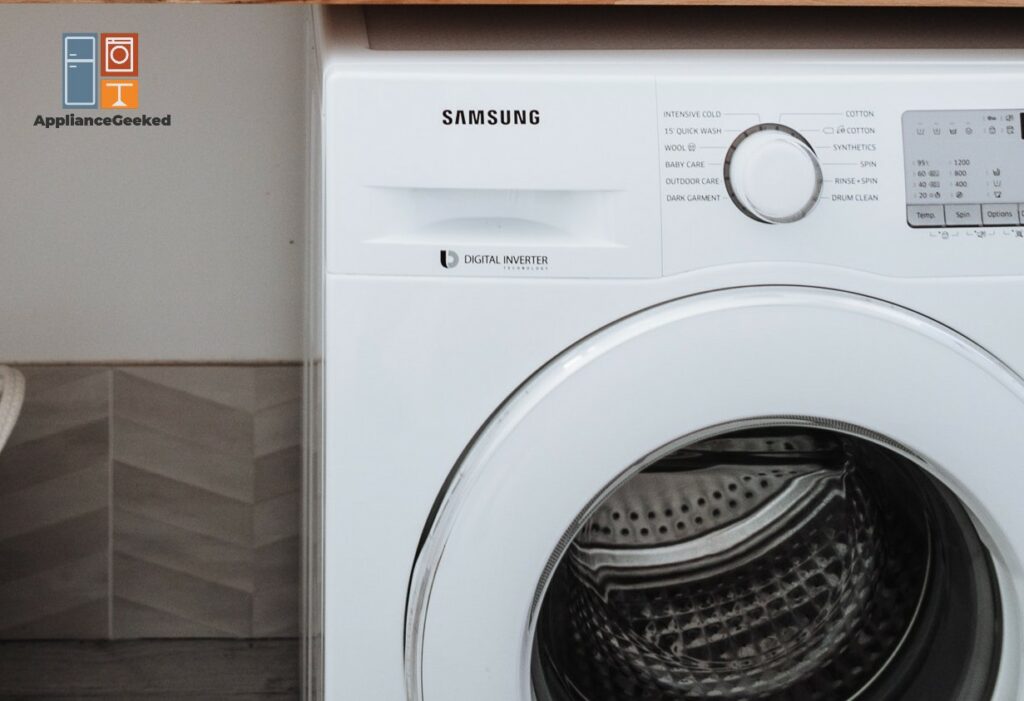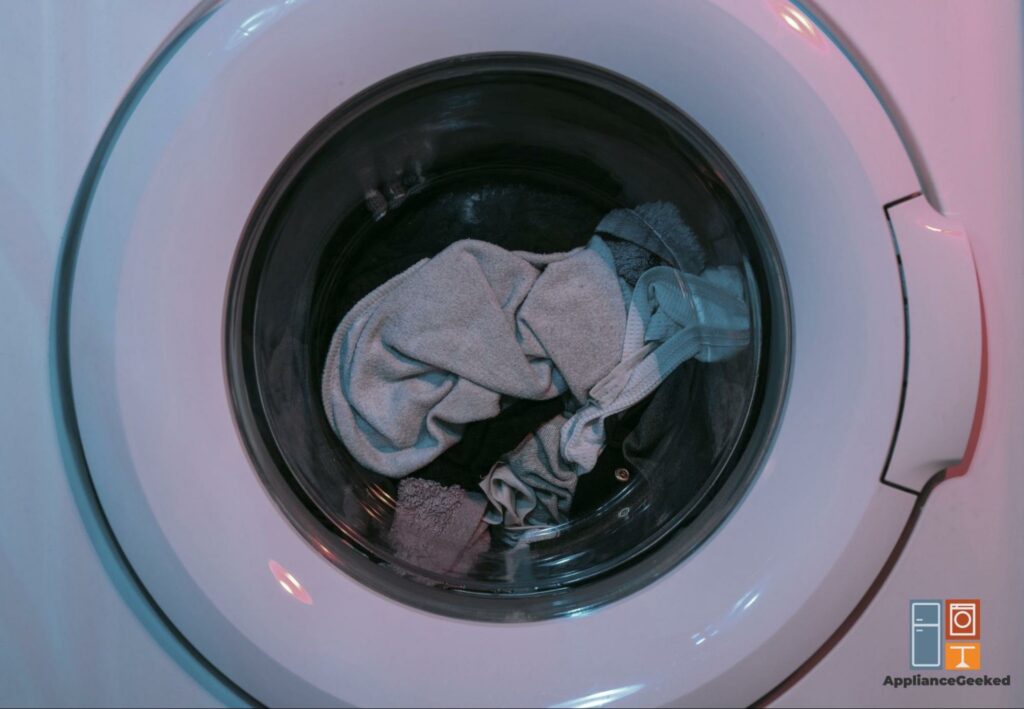Writing off laundry from your to-do list is a fulfilling feat. However, it’s difficult to finish the job if your top load washer won’t start spinning.
Your top load washer cannot rotate due to either a full washing tub or other problems ranging from broken parts to faulty smart features.
Get your tools ready and let’s give your top load washer a whirl!
Why is my top load washer not spinning?
Your top load washer isn’t spinning mainly because the washing tub is too full or the clothes inside are imbalanced.
Other problems such as a clogged drainage system, insufficient power supply, and broken machine parts may also cause the issue.
The washing unit’s smart features may also be affected by water or must be seen by a technician for further analysis.
It’s also important to distinguish if your top load washer isn’t spinning at all or if it stopped mid-cycle.
A top load machine stopping mid-cycle could be caused by a smart feature, the washer not receiving enough electricity, or the tub cannot tumble the clothes because it’s overloaded.
However, if the top load unit isn’t spinning at all, one of its machine parts is broken and needs immediate replacement.
A spin test must also be done on your washer to determine if it can still spin or not. To do this, the washing tub must first be empty of clothes and water.
Close the lid and dial on the spin cycle to start the process. Listen if the top load washer is making a noise or if the lid is opening.
If the washing tub isn’t noisy and the lid isn’t opening, then the washer can still spin and its drainage system just needs to be unclogged of debris. If the tub is noisy, then the problem lies with other machine parts like the driver motor that need replacement.
How to Fix a Top Load Washer That’s Not Spinning
Before concluding that your top load washer needs replacement, we’ve compiled some problems that may cause your washer to stop spinning and how to fix them immediately.
| Problem | Solution |
| Faulty Lid Switch | • Assess what type of lid switch your washer has. • Remove the necessary frames to reach the switch. Determine if the switch can still be used or if it needs replacement using a multimeter. • A functioning lid switch has a continuous electrical path reflecting on the multimeter, while a faulty switch doesn’t have one. • If the lid switch isn’t faulty, move forward to other washer parts to find the cause of the issue. • If not, disconnect the old switch from the assembly. Connect the new lid switch to the assembly by aligning the components and securing them with the required bolts and screws. |
| Unbalanced Washing Tub | • Check the washer’s balance with a leveling tool. Move on to other washing components if the top load unit is leveled. • If not, assess if the washer’s legs are adjustable. If the legs are mobile, position them until the appliance is balanced. • Move to reviewing the washing tub if the legs are not movable. • Check if the tub’s shock absorbers are still in mint condition. If not, unscrew the absorbers from their assembly. • Disconnect the damaged shock absorbers and replace them with new ones. • If shock absorbers are still usable or replaced but the washer is still not spinning, inspect the suspension rings. • View other components if the rings are still usable. Otherwise, remove them one by one from the frame. • Replace the damaged springs with a new set. |
| Overloaded Washing Tub | • Review the washing tub’s capacity. Manually check the washing tub by placing your hand between the tub and the laundry inside. • If your hand can move, then the clothes have space to tumble around in the washing tub. If not, you need to take out some garments from the drum. |
| Worn Out Washer Belt | • Access the pulley system typically located at the back of the top loader. • Assess if the belt is broken or still usable. • If you find damage in the washer belt, carefully remove it from the pulley system. • Install a new washer belt and realign the other components before screwing everything in position. |
| Malfunctioning Smart Features | • Check for an enabled child lock feature. Disable the lock feature or other smart feature if necessary. • If the control board is not registering any commands, unplug and plug the washer back in after 30 seconds to reset the system. • After assessing the child lock feature, ensure that the top load washer is properly plugged in. • Also, inspect if the control board has trapped condensed water. Pat the board dry if there is condensation present. • Contact a technician if the control board has complex problems that need professional attention. |
| Clogged Drainage System | • Check the drain hose and pipe for debris and clogged garments. • Use pliers to disconnect the drain hose from the pipe. Clean the compartments by using warm water and soap or a snake tool to scrape the gunk out, among other options. |
| Frayed Driver Motor | • Disconnect the hose and, if included, the standpipe from the washer. • Lay the unit on its back or side panel. • Unscrew the plastic cover to access the motor. Determine if the motor is still usable using a multimeter. • The driver motor needs a replacement if the multimeter is not registering any electric continuity in its slot. • Replace the faulty motor with a new one. Align the new motor and screw it properly. • Contact your technician if the washer still won’t start after replacing the motor. |
Faulty Lid Switch
The lid switch of your top load washer may have been affecting the spinning feature of your washer. It could have broken off or mispositioned.
There are some models of top load units that do not start a wash cycle if the lid switch is broken. Check if the lid switch underneath your washer’s lid is still functioning by assessing if its physical state is in good condition.
If the lid switch is bent or just a bit misplaced, put it back in its original position. If the washer is still not spinning, check the continuity flow of the switch using a multimeter.
The switch needs to be replaced if the multimeter isn’t registering any electrical flow from it.
Solution: A faulty lid switch needs immediate replacement. Start with unplugging your washer.
Then, unscrew the switch from its place. Remove the whole top to access the switch’s tube so you can disconnect it from the assembly.
Once removed, connect the new switch to the assembly by pressing both parts firmly together. Put the switch back in its original position and make sure that it’s facing the right direction.
Note that positions can vary depending on the washer unit. Carefully align the lid and the lid switch before screwing everything in place.
Unbalanced Washing Tub
If the washer is not spinning, the issue might be an unbalanced washing tub. It may have been unleveled due to constant usage and overloading of the laundry.
Solution: To check if you have an unbalanced washing tub, place a bubble level on the floor.
The washer is leveled if the bubble on the leveler is in the middle. Move on to other parts that could cause your washer not to spin.
On the other hand, the top load unit isn’t leveled if the bubble is either on the far right or far left of the leveler. Check if the machine’s legs are in their right positions.
If the washer’s legs are adjustable, conform each one until the washer isn’t wobbly. If they’re not adjustable, you can take a peek at the washing tub as it can also make the washer uneven.
You can also assess if your washer’s shock absorber needs replacement. A faulty shock absorber is most likely a reason why your washer won’t spin as it needs to lessen any vibrations on the tub.
You should find the shock absorber between the tub’s exterior and base frame.
Grab a screwdriver and remove the front frame of the washer. Do the same with the top panel so you can access the shock absorber.
Use the required screwdriver for your washer to detach the faulty component from the tub. Remove the bracket from the old shock absorber and place it on the new one.
Insert the new shock absorber into its original position before aligning the tub and frame. Secure the components with the screws.
Lastly, your top load washer’s suspension rings may be damaged if the washer is still not spinning after looking at the other components. The suspension rings are essential to your washer as they lessen noise and keep the washer in position.
You can find the suspension rings either above or below your washing tub. If they are still intact and straight, then move forward with the other washer parts.
Your unit’s suspension rings need immediate replacement if they are broken. Make sure that your washer is leveled before proceeding.
Remove the top cover of the washer’s frame and unscrew the malfunctioning springs if they’re above the tub. If the springs are beneath, remove the side frames first to access them.
Once accessible, take out the springs from their sockets and replace them with a new one. It’s highly advisable to remove the springs one at a time to prevent the washer from collapsing.
Carefully remove the springs from the pipes that spun around it and unhook it from the frame afterward. Once all the suspension springs are replaced, put the side frames and the top layer back in their places.
Overloaded Washing Tub
Top load washers vary in size depending on their brand. An average top load unit can carry 12 pounds of laundry for every wash cycle.
It’s a general rule to at least fill your washing tub a quarter full instead of filling it to its capacity so the tub can spin without putting too much force on itself and the motors.
Solution: You can do the palm trick to know if you put too much laundry in your washer. Put your hand between the tub and your laundry.
You don’t have an overloaded tub if your hand can still move freely between the two elements. However, if your hand can’t move, you need to take a few garments out.
Shifting the garments around can also help free some space in the washing drum. Not overloading your washing machine helps preserve the unit and avoid frequent maintenance and replacement.
Worn Out Washer Belt
The washer belt is responsible for your washer’s spinning capabilities. The appliance is most likely not working because its belt is broken or worn out.
A worn-out washer belt can make the washer noisy or even agitate, but will not make the washing tub spin.
The pulley system that the belt belongs to is typically located at the back of the appliance.
Solution: Access the system and assess the washer belt.
A usable washer belt has no visible torn and can still fit well in the pulley system. Move on to other components if the belt is still functional.
On the other hand, a worn-out washer belt has visible tears and does not fit in the pulley system. If this is the case, take the belt out of the washer and replace it with a new one.
To do the replacement, put the smaller washer components in a container to avoid misplacement. Then, put the brand-new washer belt in the pulley system and align it accordingly.
Secure the components with their designated screws and bolts.
Malfunctioning Smart Features
Your washing machine’s smart features and control board can also have issues that cause the washer’s spinning problem.
Solution: Ensure that your appliance is properly plugged in as insufficient electricity flow may cause the control board to cancel any inputs.
If your washer has a child lock feature, check if it’s enabled because it may be why you can’t run a wash cycle. Depending on your unit, the child lock button and indicator will light up if it’s engaged.
Simply push the child lock button to disable the smart feature. Assess the other buttons on the control board and either disable or enable any wash cycle-related buttons if necessary.
On another note, moisture can also affect the control board because water can cause it to malfunction. Ensure the board and its buttons aren’t wet with condensed water or water from the previous wash cycles.
Is the control board not registering any commands? Unplugging your washing machine and plugging it back in after at least 30 seconds resets the system.
TIP: It’s also notable to check your washing machine’s manual to see more detailed functions of your top load washing machine. However, the control board must be checked by a technician if it’s not registering any commands.
Clogged Drainage Systems
There are also some top load washing machines that check their drainage systems before starting or continuing a wash cycle.
Your washer’s drainage hose may be full of lint and debris — there could even be small garments stuck in there! A clogged hose means that water cannot drain from the tub and clothes, which interferes with the washer’s spinning system.
Solution: Unplug your washer before checking the washing unit’s drainage system. Then, access the drainage, which is typically at the back of the appliance.
Replace the hose if it’s visually damaged or worn out. If it’s not visually damaged, disconnect the hose from the washer to clean it.
Once the hose is removed, clean the pipe and the hose of any debris that you may see. You can opt to use the snake tool, a sponge, or even white vinegar with a dash of baking soda to eliminate both waste and foul odor.
Frayed Driver Motor
A burnt-out driver motor greatly affects a washing machine because it’s the main attributor to the appliance’s spinning capabilities.
A malfunctioning driver motor stops your wash cycle mid-spin even though the washing tub can still retain water and agitate.
Solution: You can assess if the motor is faulty by using a multimeter and checking for its electric continuity. If there is no electrical flow, the motor needs immediate replacement.
To replace the motor, unplug your washing machine. Then, use pliers to disconnect the hose, and if your unit has one, the standpipe from the washer.
Lay down the appliance on its back or front panel to access the motor. Use the required screwdriver to remove the plastic cover of the motor.
Carefully place the bolts in a container to prevent misplacing a piece. Store the panels and other components safely as well.
Finally, remove the old motor and replace it with a new one. Screw the new motor into place once it’s positioned.
After returning the washer components back and securing them with their proper bolts and screws, put the panels back. You can finally stand your top load unit up.
Replacing the driver motor can be a tedious job. Contact your technician if you have doubts about performing such a task.
While top load washing machines are known for their robust qualities and ability to remove tougher stains, they’re not invisible to the elements that could potentially be their Kryptonite.
Nonetheless, top loaders that can’t spin aren’t necessarily broken, but some of their parts may need replacement or cleaning. However, it’s important to note that you can leave both responsibilities to technicians if you aren’t sure you can handle them yourself.




